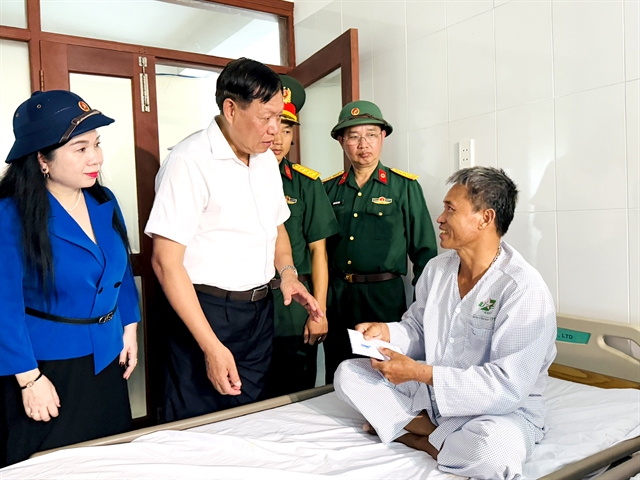 Opinion
Opinion


|
| Deputy Minister of Health Đỗ Xuân Tuyên and Dr Phan Lê Thu Hằng, deputy director of the health ministry's Planning and Finance Department, visit the Spratly Island Military-Civilian Medical Centre in late April. — Photo suckhoedoisong.vn |
Digital transformation in health services on islands and maritime zones is essential to improve the quality of care for soldiers and residents in these special areas. Associate Professor Dr Phan Lê Thu Hằng, deputy director of the Ministry of Health’s Planning and Finance Department, spoke to Sức khỏe & Đời sống (Health & Life) newspaper about the transformation, following a recent working visit to the Spratly Islands.
How is the progress of digital transformation in health services on islands and maritime zones in your observations?
At the end of April, Working Group No 12, comprising representatives from the Naval Services and the Ministry of Health (MoH), conducted a working visit with soldiers and residents on the islands of Sinh Tồn, Cô Lin, Đá Đông A, Đá Tây C, Trường Sa and the DK1 platforms.
This was also an MoH’s field survey, as part of its efforts to implement the national strategy on maritime and island healthcare until 2030, as approved by the Prime Minister.
The survey showed that while many challenges remain, medical services for soldiers and civilians on the Spratlys have significantly improved. Notably, the telemedicine system has been effectively maintained and has produced significant results.
We know that in special areas like the Spratlys, with their long distances to the mainland, small-sized islands and limited populations, the building of large-scale medical facilities is not practical.
Instead, we need to prioritise health stations capable of providing basic medical care and emergency services, supported by real-time technical assistance from mainland medical facilities when needed.
Digital transformation in maritime and island healthcare is crucial for enhancing the capacity of the health system in these special zones.
Thanks to the rapid progress of digital technologies and improved IT infrastructure in disadvantaged areas, this transformation is becoming increasingly feasible.
However, it should be noted that digital transformation on more remote islands is facing bigger technical and financial challenges, such as maintaining stable operation of equipment in high-salinity environments, higher investment costs, as well as ensuring adequate human resources.
To ensure effective digital transformation for maritime and island healthcare, coastal cities and provinces must invest in network infrastructure, provide digital training for medical staff, and guide local communities to use smart apps to access information on healthcare and take proactive action for their well-being.
Health stations on islands often face shortages of equipment, medicine and medical staff, which pose difficulties for residents in accessing primary healthcare and medical treatment and examination. What would be the ministry’s specific solutions to address this situation?
Ensuring healthcare capacity in remote and hard-to-reach areas is a common challenge for many countries, especially middle-income nations like Việt Nam.
Strengthening the grassroots health network in such regions is a top priority of the health sector both in the short term and the long run.
In the past years and especially recently, the ministry and local authorities have mobilised resources to upgrade grassroots health facilities in disadvantaged areas. This includes improving infrastructure, developing human resources, strengthening management capacity, and reforming primary healthcare delivery models. These efforts have yielded significant results in improving health service capacity and quality.
Currently, the MoH is developing a proposal for the national target programme on health, population and development for the 2026-35 period. This aims to introduce foundational and catalytic interventions to boost grassroots health systems in the new context, particularly with the proposed two-tier local government structures.
Solutions include investments in infrastructure and medical equipment, grassroots healthcare staff training and service delivery improvements and the application of digital technologies for comprehensive health monitoring, consultation and management.
According to the administrative units merger plan, some inland provinces with mountainous and remote areas will soon be expanded to include coastal and island zones. What challenges might arise in implementing maritime and island health programmes in these areas?
The plan to merge administrative units at the commune and provincial levels, in addition to increasing opportunities to expand the geographical spaces for socio-economic growth, can also impose higher demands on local health system management. Following the mergers, the local populations will be larger and the service areas will become more diverse, ranging from inland border zones, maritime and island areas to mountainous and delta regions.
One advantage is that existing coastal and island localities, although merged into larger units, will remain the core drivers of maritime and island development, including healthcare. The experienced personnel currently managing these areas will continue their roles.
We believe that officials and staff in the newly expanded provinces will swiftly familiarise themselves with maritime and island policies to ensure the seamless integration of this scope of work into broader socio-economic growth.
The MoH will continue working closely with these localities to effectively implement maritime and island healthcare programmes.
Going forward, the implementation of the maritime and island healthcare programme must focus on two key priorities. The first is enhancing the capacity of the health system to better meet the needs of coastal and island communities. The second is providing effective support for the economic transformation in these areas, such as the increase of industrial zones, logistics hubs, trade centres and tourism destinations. — VNS




